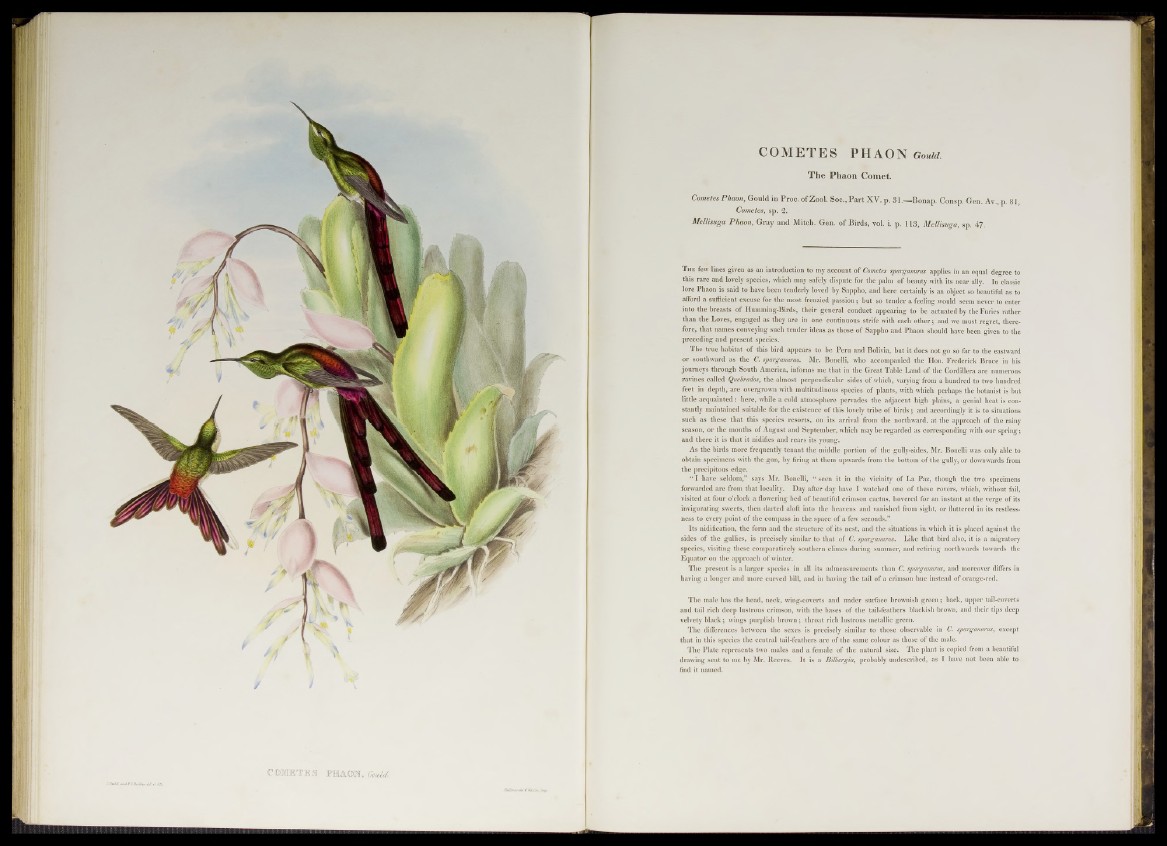
COMETES PHAON Gould.
The Phaon Comet.
Cometes Phaon, Gould in Proo. ofZool. Soc.,Part XV. p. 31.—Bonap. Consp. Gen. Ay., p. 81,
Cometes, sp. 2.
Mellisuga Phaon, Gray and Mitch. Gen. o f Birds, vol. i. p. 113, Mellisuga, sp. 47.
T he few lines given as an introduction to my account of Cometes sparganurus applies in an equal degree to
this rare and lovely species, which may safely dispute for the palm of beauty with its near ally. In classic
lore Phaon is said to have been tenderly loved by Sappho, and here certainly is an object so beautiful as to
afford a sufficient excuse for the most frenzied passion j but so tender a feeling would seem never to enter
into the breasts of Humming-Birds, their general conduct appearing to be actuated by the Furies rather
than the Loves, engaged as they are in one continuous strife with each other; and we must regret, therefore,
that names conveying such tender ideas as those of Sappho and Phaon should have been given to the
preceding and present species.
The true habitat of this bird appears to be Peru and Bolivia, but it does not go so far to the eastward
or southward as the C. sparganurus. Mr. Bonelli, who accompanied the Hon. Frederick Bruce in his
journeys through South America, informs me that in the Great Table Land of the Cordillera are numerous
ravines called Quebrados, the almost perpendicular sides of which, varying from a hundred to two hundred
feet in depth, are overgrown with multitudinous species of plants, with which perhaps the botanist is but
little acquainted: here, while a cold atmosphere pervades the adjacent high plains, a genial heat is constantly
maintained suitable for the existence of this lovely tribe of birds; and accordingly it is to situations
such as these that this species resorts, on its arrival from the northward, at the approach of the rainy
season, or the months of August and September, which may be regarded as corresponding with our spring;
and there it is that it nidifies and rears its young.
As the birds more frequently tenant the middle portion of the gully-sides, Mr. Bonelli was only able to
obtain specimens with the gun, by firing at them upwards from the bottom of the gully, or downwards from
the precipitous edge.
“ I have seldom,” says Mr. Bonelli, “ seen it in the vicinity of La Paz, though the two specimens
forwarded are from that locality. Day after day have I watched one of these rovers, which, without fail,
visited at four o’clock a flowering bed of beautiful crimson cactus, hovered for an instant at the verge of its
invigorating sweets, then darted aloft into the heavens and vanished from sight, or fluttered in its restlessness
to every point of the compass in the space of a few seconds.”
Its nidification, the form and the structure of its nest, and the situations in which it is placed against the
sides of the gullies, is precisely similar to that of C. sparganurus. Like that bird also, it is a migratory
species, visiting these comparatively southern climes during summer, and retiring northwards towards the
Equator on the approach of winter.
The present is a larger species in all its admeasurements than C. sparganurus, and moreover differs in
having a longer and more curved bill, and in having the tail of a crimson hue instead of orange-red.
The male has the head, neck, wing-coverts and under surface brownish green; back, upper tail-coverts
and tail rich deep lustrous crimson, with the bases of the tail-feathers blackish brown, and their tips deep
velvety black; wings purplish brown ; throat rich lustrous metallic green.
The differences between the sexes is precisely similar to those observable in C. sparganurus, except
that in this species the central tail-feathers are of the same colour as those of the male.
The Plate represents two males and a female of the natural size. The plant is copied from a beautiful
drawing sent to me by Mr. Reeves. It is a Bilbergia, probably undescribed, as I have not been able to
find it named.